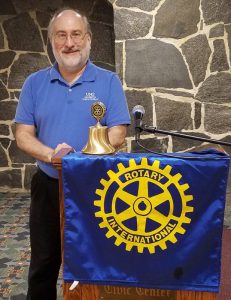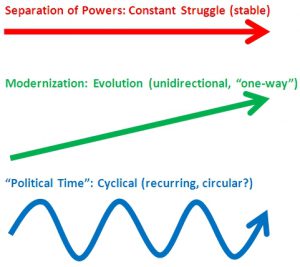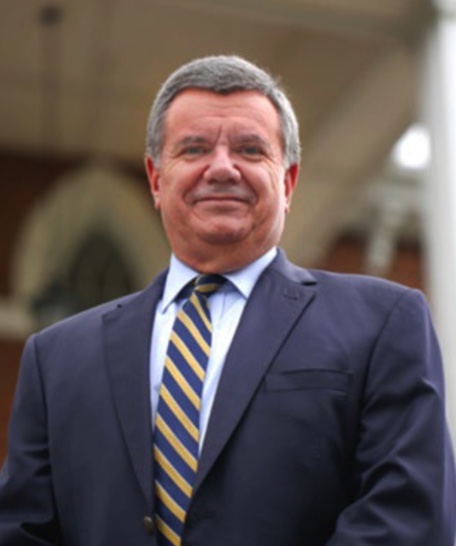U.S PRESIDENTS ARE INCREASINGLY DEPENDENT ON PUBLIC APPROVAL, DR. CAVALLI REPORTS
The framers of the U.S. Constitution did not foresee the dependence of presidents on public approval, but that dependence now determines presidents’ success, Dr. Carl D. Cavalli, professor of political science on the Dahlonega campus, told the Gainesville Rotary Club on Tuesday, February 21.

Dr. Cavalli was the club’s special guest as it commemorated President’s Day. The club invited him to address the the group on “The Evolution of the Presidency.” He focused on three observed dynamics (as illustrated by the accompanying graphic below).
The first is the stable dynamic of the Constitution, which, he said, “either doesn’t change or changes very slowly.” It is the constant of constitutional powers like that of commander-in-chief, the veto power, and the unending struggle of checks and balances.
The second is an evolutionary dynamic that has seen presidential leadership become increasingly dependent upon public support (as observed by political scientist Jeffrey Tulis) — something the framers had not anticipated. There were hints of this as early as the populism of Andrew Jackson, but this dynamic became a full-blown rival to formal constitutional powers by the twentieth century. Unlike the constitutional constant, public support can vary quite a bit, either empowering or constraining modern presidents. As examples, Dr. Cavalli discussed the two Bush presidencies, both of which saw early successes with record-high approval and later impotence with near record-low approval.
 The final dynamic involves observable cycles, both within and across administrations, and is closely tied to the evolutionary dynamic. Within administrations, we see a predictable pattern of public support where new presidents are awarded a “honeymoon” of relatively high public approval (although this does not seem to be the case for the current administration), followed by a steady decline from which most presidents recover just enough to win reelection. Across administrations, we see the rise and fall of “regimes” (as observed by political scientist Stephen Skowronek). New regimes are built on repudiating a collapsing regime. Presidents who are fortunate to preside at such a time have a free hand to achieve significant change. They often appear near the top of presidential rankings. One such example is Franklin Roosevelt and the New Deal regime. These regime-building presidents are followed by “faithful sons,” who ride the wave of the regime, but are also constrained by it — less likely to achieve great change. Harry Truman, John Kennedy, and Lyndon Johnson are the faithful sons of the New Deal regime. Dr. Cavalli also noted that some presidents come to power unaffiliated with the current regime. These presidents, like Dwight Eisenhower and Richard Nixon during the New Deal regime, cannot repudiate the current regime, so they argue that they can manage it better. Then there are what Dr. Cavalli called the “pitiable” presidents, such as Herbert Hoover and Jimmy Carter, who are constrained to preside over collapsing regimes.
The final dynamic involves observable cycles, both within and across administrations, and is closely tied to the evolutionary dynamic. Within administrations, we see a predictable pattern of public support where new presidents are awarded a “honeymoon” of relatively high public approval (although this does not seem to be the case for the current administration), followed by a steady decline from which most presidents recover just enough to win reelection. Across administrations, we see the rise and fall of “regimes” (as observed by political scientist Stephen Skowronek). New regimes are built on repudiating a collapsing regime. Presidents who are fortunate to preside at such a time have a free hand to achieve significant change. They often appear near the top of presidential rankings. One such example is Franklin Roosevelt and the New Deal regime. These regime-building presidents are followed by “faithful sons,” who ride the wave of the regime, but are also constrained by it — less likely to achieve great change. Harry Truman, John Kennedy, and Lyndon Johnson are the faithful sons of the New Deal regime. Dr. Cavalli also noted that some presidents come to power unaffiliated with the current regime. These presidents, like Dwight Eisenhower and Richard Nixon during the New Deal regime, cannot repudiate the current regime, so they argue that they can manage it better. Then there are what Dr. Cavalli called the “pitiable” presidents, such as Herbert Hoover and Jimmy Carter, who are constrained to preside over collapsing regimes.
At the end, Dr. Cavalli fielded several questions from the audience on topics ranging from the Electoral College to third parties to the presidency of Gerald Ford.


